Non Functional Testing_Sampath kumar Mohan
Download as ppt, pdf0 likes1,161 views
This document provides an overview of non-functional testing, including usability testing, performance testing, and compatibility testing. It discusses testing applications against client requirements rather than business requirements. Usability testing evaluates how easy a system is to use and learn. Performance testing determines how responsive and stable a system is under various workloads. Compatibility testing checks if a system works across different environments.
1 of 10
Downloaded 38 times

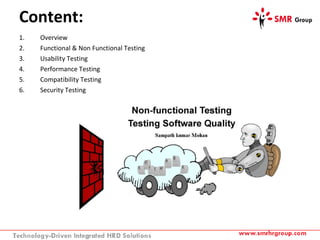
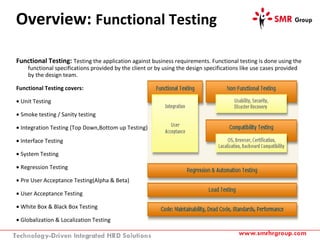

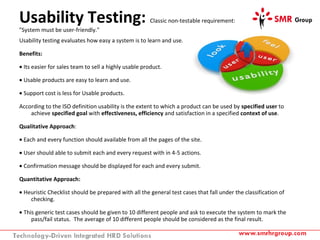
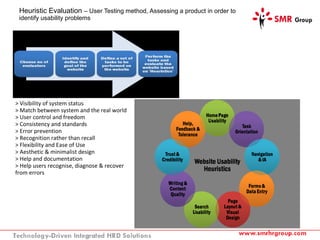
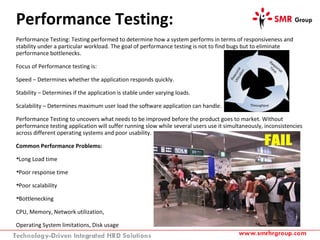
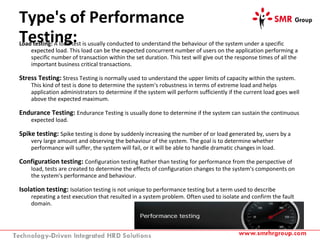

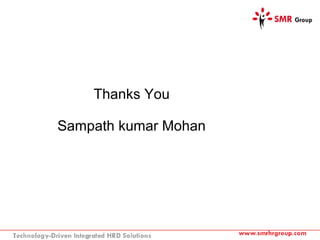
Ad
Recommended
The importance of non functional testing
The importance of non functional testingMaveric Systems
╠²
Non-functional testing is essential for assessing the overall performance and quality of newly developed software, ensuring that any faults are identified and corrected. This type of testing involves various methods to examine characteristics such as maintainability, usability, and operability, which are critical for both manufacturers and users. The process typically follows unit testing and includes integrated testing, ultimately aiming to guarantee software reliability before it reaches users.What are the advantages of non functional testing
What are the advantages of non functional testingMaveric Systems
╠²
Non-functional testing is critical in software development to assess aspects such as performance, usability, and reliability, which directly affect user experience. It aims to identify bugs that could cost the U.S. economy $60 billion annually, emphasizing the need for effective testing methods to mitigate risks. Various testing techniques are utilized, including black box, white box, and alpha/beta testing, to ensure software meets customer requirements before deployment.Non functional testing
Non functional testingVaibhav Dash
╠²
Non-functional testing checks how well a product works by focusing on characteristics like reliability, usability, efficiency, maintainability, and portability. It tests customer expectations and includes performance testing to check a system's speed, load testing to see how it behaves under normal and peak usage, stress testing beyond its capabilities, and usability, reliability, and portability testing.Difference between functional testing and non functional testing
Difference between functional testing and non functional testingpooja deshmukh
╠²
The document compares functional and non-functional testing, highlighting that non-functional testing evaluates aspects like performance, security, and scalability, while functional testing focuses on business requirements and expected outcomes. It outlines various types and stages of each testing approach, emphasizing the importance of both in software development. The article serves as a resource for students learning about software testing concepts.Non-functional testing
Non-functional testingVishwanath KC
╠²
Non-functional testing assesses how well a product behaves rather than what it does. It evaluates attributes like reliability, performance, usability, maintainability, and portability. Reliability testing checks that software operates failure-free for a specified time and helps identify recurring failures. Performance is tested under various loads to measure response times. Usability ensures features are easy to understand and use. Maintainability permits software to be updated and modified over its lifecycle. Portability testing verifies how effortless it is to transfer software between environments.Non-Functional testing
Non-Functional testingKanoah
╠²
Kanoah Tests provides a comprehensive test management solution integrated seamlessly with Jira, enabling effective coordination of test activities for both agile and traditional teams. The tool supports various non-functional testing types, ensuring software quality by evaluating performance, security, usability, and more. Recommended by users for its efficient management and excellent customer support, Kanoah Tests simplifies the testing process without the complexity of other tools.Non-functional Testing (NFT) Overview
Non-functional Testing (NFT) Overview Assaf Halperin
╠²
This document discusses the importance of non-functional testing (NFT) in software development. It defines NFT as testing aspects of a product that are not direct functional requirements, such as performance, reliability, security, and usability. The document recommends implementing NFT throughout the entire development lifecycle from development to post-production in order to reduce risks, costs, and improve quality. It provides examples of different types of NFT and emphasizes the resources required to properly perform serious NFT.softwaretestingppt-FINAL-PPT-1
softwaretestingppt-FINAL-PPT-1FAIZALSAIYED
╠²
The document discusses various aspects of software testing such as the definitions of testing, different testing methodologies like black box and white box testing, testing levels from unit to acceptance testing, and performance testing types including stress, recovery, and compatibility testing. It also covers testing tools, test plans, test cases, and the software development life cycle.Software testing career 20180929 update
Software testing career 20180929 updateAhmed Ahmed Mokhtar
╠²
The document covers key aspects of software testing and quality assurance, including the software development life cycle (SDLC), various testing methodologies, the importance of quality control, and the steps to launching a career in software quality. It outlines the difference between functional and non-functional testing, types of tests (like unit, integration, and user acceptance tests), and highlights the significance of testing in preventing costly errors. Additionally, it lists tools, freelancing websites, and valuable resources for aspiring testers.Software testing career
Software testing careerAhmed Ahmed Mokhtar
╠²
The document outlines important aspects of a career in software testing, including the software development life cycle (SDLC), the distinction between quality control and quality assurance, and various testing types. It emphasizes the significance of testing in reducing costs and increasing customer satisfaction while detailing the processes of writing test cases and managing bugs. Additionally, it provides resources for further learning and platforms for finding freelance testing opportunities.Non Functional Test Management
Non Functional Test ManagementMartin Croft Bsc(Hons) MBCS CITP
╠²
The document discusses non-functional testing (NFT) and provides advice on common issues, managing risk, and areas for improvement. It notes that NFT is often poorly defined, planned, and executed. It recommends fostering common understanding of NFT, engaging stakeholders early, setting clear test catalogs, and integrating NFT into design, development, and monitoring. The document also provides the author's experience and contact information for consulting services.What Is Functional Testing?
What Is Functional Testing?QA InfoTech
╠²
Functional testing is a software testing approach that assesses applications against functional requirements to identify defects. It involves several steps, including identifying expected functions, creating input data, executing test cases, and comparing outputs. Different types of functional testing include smoke testing, sanity testing, regression testing, and user acceptance testing, all of which are essential for ensuring the software meets user demands and quality standards.Performance testing
Performance testing BugRaptors
╠²
Performance testing assesses the speed and effectiveness of systems, focusing on key factors like throughput and response time. It includes various types such as load, stress, volume, security, and recovery testing, aimed at ensuring systems meet performance requirements under varying conditions. The process involves planning, recording, modifying, executing tests, monitoring, and analyzing results to identify bottlenecks and improve performance.Software Testing Training in Chandigarh
Software Testing Training in ChandigarhKreativan Technologies
╠²
The document provides a comprehensive overview of software testing, including its definition, benefits, objectives, and common terminologies. It describes the software testing process and effective testing methods such as alpha, beta, regression, white box, and black box testing. Additionally, it highlights Kreativan Technologies as a leading provider of software testing training in Chandigarh.Non Functional Testing
Non Functional TestingNishant Worah
╠²
The document discusses various types of non-functional testing including performance, reliability, maintainability, availability, recovery, usability, configuration, and security testing. It provides definitions and examples of how to test each type of non-functional requirement. Performance testing aims to evaluate how well a system performs under different loads, and involves measuring response times, throughput, and resource utilization. Non-functional requirements are as important as functional requirements in building quality software.Functional Testing vs Non-Functional Testing | Edureka
Functional Testing vs Non-Functional Testing | EdurekaEdureka!
╠²
The document outlines software testing as a process to evaluate a software application's functionality against specified requirements to ensure a quality product. It distinguishes between functional testing, which focuses on user requirements, and non-functional testing, which assesses system attributes like performance and memory management. Additionally, it lists various types of testing such as unit, integration, and performance testing, along with real-world use cases.SOFTWARE TESTING
SOFTWARE TESTINGRaju Raaj
╠²
The document discusses software testing and quality assurance. It describes the importance of testing in the software development life cycle (SDLC) and outlines different types of testing like unit testing, integration testing, and system testing. It also defines key terms like bugs, faults, errors, and failures. Verification is described as confirming the software meets its specifications while validation confirms it meets user requirements. The quality of software is defined and a bug reporting lifecycle is presented.Software Testing
Software Testing MD SALEEM QAISAR
╠²
This document presents an overview of software testing. It defines software testing as evaluating a program or application under various conditions to check that it meets specifications, functions as intended, and is of high quality. The document outlines objectives of testing like uncovering errors, validating requirements, and generating high-quality test cases. It also defines key terms, describes testing methodologies like black box and white box testing, different testing levels from unit to system, and various types of tests.Configuration testing
Configuration testingfarouq umar
╠²
This document discusses configuration testing and management. Configuration testing involves testing software and systems on different hardware and software combinations to check for compatibility issues. It is important because the number of possible configurations is usually too large to fully test. Configuration management is also important for tracking what is being tested and different versions. Hardware and software configuration testing both help ensure compatibility and identify issues across environments.Testing types functional and nonfunctional - Kati Holasz
Testing types functional and nonfunctional - Kati HolaszHolasz Kati
╠²
The document outlines the types of functional and non-functional testing in software development, detailing various methods including unit, integration, system, and acceptance testing, among others. It explains the purpose and process of each testing type, highlighting differences between functional requirements (what the product does) and non-functional requirements (how well the product performs). Additionally, it covers aspects such as usability, performance, security, portability, localization, and installation testing.acceptance testing
acceptance testingSaleem Almaqashi
╠²
Acceptance testing is formal testing conducted by customers or suppliers to determine if a system meets its acceptance criteria. There are two types: user acceptance testing conducted by customers, and business acceptance testing conducted by suppliers. Acceptance criteria are selected based on quality attributes like functionality, performance, and reliability. An acceptance test plan is created and the testing is executed in two phases, with basic then complex test cases. Test reports are generated to determine if the system should be accepted, accepted with modifications, or not accepted. In extreme programming, user stories serve as acceptance criteria and associated tests verify the criteria are met.Quality Control
Quality Controlnethisip13
╠²
The document discusses quality control and software assurance techniques. It defines quality control as a series of inspections, reviews and tests used throughout development to ensure requirements are met. It distinguishes between verification, ensuring software implements specific functions, and validation, ensuring software meets customer requirements. Static analysis techniques like reviews and inspections are discussed for evaluating software without execution, while dynamic analysis involves software execution. Different review techniques like personal reviews, inspections, walkthroughs and formal reviews are outlined.Functional Testing Tutorial | Edureka
Functional Testing Tutorial | EdurekaEdureka!
╠²
This document provides an overview of functional testing. It defines functional testing as verifying that each function of a software application operates as specified. It discusses the differences between functional and non-functional testing, the objective and focus of each. Steps in functional testing are identified as determining functionality, creating test data, determining expected outputs, executing test cases, and comparing actual and expected outputs. Types of functional testing and techniques are described along with advantages of the Selenium tool for automation.Building a software testing environment
Building a software testing environmentHimanshu
╠²
This document discusses building a software testing environment. It emphasizes that senior management is responsible for creating an environment conducive to effective and efficient testing. This involves addressing topics like management's risk appetite, the role of testing, testing policies, support provided, and resources allocated. It also discusses developing a testing strategy that identifies test factors and phases to reduce risks. The strategy is represented as a test factor/test phase matrix that maps risks to development phases. Overall, the document provides guidance on how management can support testing and stresses the importance of a structured, risk-based approach.Testing Types And Models
Testing Types And Modelsnazeer pasha
╠²
The document discusses different types of testing in the V-model, including static testing, dynamic testing, unit testing, integration testing, system testing, acceptance testing, and more. It provides details on each type of testing including what is tested, when it is performed, and the objectives.Types of software testing
Types of software testingAbdullah Al Rumy
╠²
The document describes different types of software testing, including usability testing, functional testing, and non-functional testing. Usability testing includes user interface and manual support testing. Functional testing involves functionality, sanity, and smoke testing. Non-functional testing covers areas such as internationalization, recovery, compatibility, configuration, intersystem, installation, localization, performance, load, stress, data volume, parallel, and security testing. The document provides brief definitions and explanations of each type of testing.S.t.
S.t.Prashant Gupta
╠²
Software testing is the process of identifying errors, completeness, and quality of software. It involves executing programs under different conditions through manual or automated means to uncover as many errors as possible. The goal is to demonstrate that the software meets requirements specifications with minimum cost and effort. There are different types of testing like unit, integration, and system testing that occur at various stages of the software development life cycle. Test cases are specific procedures used to test requirements and include identification of what is being tested, success and failure criteria, test steps, and test data.Software testing
Software testingFarhanullah khan
╠²
The document discusses various types of software testing that take place during the software development life cycle (SDLC). It defines key terms like bugs, faults, and failures. It then explains different types of testing like unit testing, system testing, usability testing, functional testing, security testing, alpha testing, acceptance testing, beta testing, regression testing, and monkey testing. The overall purpose of software testing is to identify issues, ensure quality, and validate that requirements are met before releasing the software to end users.What is Performance Testing?
What is Performance Testing?QA InfoTech
╠²
Performance testing assesses an application/system's performance attributes, such as responsiveness and scalability, under various load conditions, playing a crucial role in the software development lifecycle. Different load testing types are outlined, including benchmark, load, step-up, stability, stress, scalability, spike, isolation, volume, and configuration tests. Agile performance testing is emphasized to identify bottlenecks early in the development process, incorporating continuous integration and monitoring for effective outcomes.Testing ppts 20 march
Testing ppts 20 marchsiddharth rathore
╠²
This document discusses performance, acceptance, and stress testing. It defines each type of testing and outlines the typical processes involved. Performance testing checks a system's speed, scalability, and stability under varying loads without attempting to find bugs. Stress testing evaluates a system's robustness and error handling under extreme loads. Acceptance testing determines if a system meets requirements specifications before user acceptance.More Related Content
What's hot (20)
Software testing career 20180929 update
Software testing career 20180929 updateAhmed Ahmed Mokhtar
╠²
The document covers key aspects of software testing and quality assurance, including the software development life cycle (SDLC), various testing methodologies, the importance of quality control, and the steps to launching a career in software quality. It outlines the difference between functional and non-functional testing, types of tests (like unit, integration, and user acceptance tests), and highlights the significance of testing in preventing costly errors. Additionally, it lists tools, freelancing websites, and valuable resources for aspiring testers.Software testing career
Software testing careerAhmed Ahmed Mokhtar
╠²
The document outlines important aspects of a career in software testing, including the software development life cycle (SDLC), the distinction between quality control and quality assurance, and various testing types. It emphasizes the significance of testing in reducing costs and increasing customer satisfaction while detailing the processes of writing test cases and managing bugs. Additionally, it provides resources for further learning and platforms for finding freelance testing opportunities.Non Functional Test Management
Non Functional Test ManagementMartin Croft Bsc(Hons) MBCS CITP
╠²
The document discusses non-functional testing (NFT) and provides advice on common issues, managing risk, and areas for improvement. It notes that NFT is often poorly defined, planned, and executed. It recommends fostering common understanding of NFT, engaging stakeholders early, setting clear test catalogs, and integrating NFT into design, development, and monitoring. The document also provides the author's experience and contact information for consulting services.What Is Functional Testing?
What Is Functional Testing?QA InfoTech
╠²
Functional testing is a software testing approach that assesses applications against functional requirements to identify defects. It involves several steps, including identifying expected functions, creating input data, executing test cases, and comparing outputs. Different types of functional testing include smoke testing, sanity testing, regression testing, and user acceptance testing, all of which are essential for ensuring the software meets user demands and quality standards.Performance testing
Performance testing BugRaptors
╠²
Performance testing assesses the speed and effectiveness of systems, focusing on key factors like throughput and response time. It includes various types such as load, stress, volume, security, and recovery testing, aimed at ensuring systems meet performance requirements under varying conditions. The process involves planning, recording, modifying, executing tests, monitoring, and analyzing results to identify bottlenecks and improve performance.Software Testing Training in Chandigarh
Software Testing Training in ChandigarhKreativan Technologies
╠²
The document provides a comprehensive overview of software testing, including its definition, benefits, objectives, and common terminologies. It describes the software testing process and effective testing methods such as alpha, beta, regression, white box, and black box testing. Additionally, it highlights Kreativan Technologies as a leading provider of software testing training in Chandigarh.Non Functional Testing
Non Functional TestingNishant Worah
╠²
The document discusses various types of non-functional testing including performance, reliability, maintainability, availability, recovery, usability, configuration, and security testing. It provides definitions and examples of how to test each type of non-functional requirement. Performance testing aims to evaluate how well a system performs under different loads, and involves measuring response times, throughput, and resource utilization. Non-functional requirements are as important as functional requirements in building quality software.Functional Testing vs Non-Functional Testing | Edureka
Functional Testing vs Non-Functional Testing | EdurekaEdureka!
╠²
The document outlines software testing as a process to evaluate a software application's functionality against specified requirements to ensure a quality product. It distinguishes between functional testing, which focuses on user requirements, and non-functional testing, which assesses system attributes like performance and memory management. Additionally, it lists various types of testing such as unit, integration, and performance testing, along with real-world use cases.SOFTWARE TESTING
SOFTWARE TESTINGRaju Raaj
╠²
The document discusses software testing and quality assurance. It describes the importance of testing in the software development life cycle (SDLC) and outlines different types of testing like unit testing, integration testing, and system testing. It also defines key terms like bugs, faults, errors, and failures. Verification is described as confirming the software meets its specifications while validation confirms it meets user requirements. The quality of software is defined and a bug reporting lifecycle is presented.Software Testing
Software Testing MD SALEEM QAISAR
╠²
This document presents an overview of software testing. It defines software testing as evaluating a program or application under various conditions to check that it meets specifications, functions as intended, and is of high quality. The document outlines objectives of testing like uncovering errors, validating requirements, and generating high-quality test cases. It also defines key terms, describes testing methodologies like black box and white box testing, different testing levels from unit to system, and various types of tests.Configuration testing
Configuration testingfarouq umar
╠²
This document discusses configuration testing and management. Configuration testing involves testing software and systems on different hardware and software combinations to check for compatibility issues. It is important because the number of possible configurations is usually too large to fully test. Configuration management is also important for tracking what is being tested and different versions. Hardware and software configuration testing both help ensure compatibility and identify issues across environments.Testing types functional and nonfunctional - Kati Holasz
Testing types functional and nonfunctional - Kati HolaszHolasz Kati
╠²
The document outlines the types of functional and non-functional testing in software development, detailing various methods including unit, integration, system, and acceptance testing, among others. It explains the purpose and process of each testing type, highlighting differences between functional requirements (what the product does) and non-functional requirements (how well the product performs). Additionally, it covers aspects such as usability, performance, security, portability, localization, and installation testing.acceptance testing
acceptance testingSaleem Almaqashi
╠²
Acceptance testing is formal testing conducted by customers or suppliers to determine if a system meets its acceptance criteria. There are two types: user acceptance testing conducted by customers, and business acceptance testing conducted by suppliers. Acceptance criteria are selected based on quality attributes like functionality, performance, and reliability. An acceptance test plan is created and the testing is executed in two phases, with basic then complex test cases. Test reports are generated to determine if the system should be accepted, accepted with modifications, or not accepted. In extreme programming, user stories serve as acceptance criteria and associated tests verify the criteria are met.Quality Control
Quality Controlnethisip13
╠²
The document discusses quality control and software assurance techniques. It defines quality control as a series of inspections, reviews and tests used throughout development to ensure requirements are met. It distinguishes between verification, ensuring software implements specific functions, and validation, ensuring software meets customer requirements. Static analysis techniques like reviews and inspections are discussed for evaluating software without execution, while dynamic analysis involves software execution. Different review techniques like personal reviews, inspections, walkthroughs and formal reviews are outlined.Functional Testing Tutorial | Edureka
Functional Testing Tutorial | EdurekaEdureka!
╠²
This document provides an overview of functional testing. It defines functional testing as verifying that each function of a software application operates as specified. It discusses the differences between functional and non-functional testing, the objective and focus of each. Steps in functional testing are identified as determining functionality, creating test data, determining expected outputs, executing test cases, and comparing actual and expected outputs. Types of functional testing and techniques are described along with advantages of the Selenium tool for automation.Building a software testing environment
Building a software testing environmentHimanshu
╠²
This document discusses building a software testing environment. It emphasizes that senior management is responsible for creating an environment conducive to effective and efficient testing. This involves addressing topics like management's risk appetite, the role of testing, testing policies, support provided, and resources allocated. It also discusses developing a testing strategy that identifies test factors and phases to reduce risks. The strategy is represented as a test factor/test phase matrix that maps risks to development phases. Overall, the document provides guidance on how management can support testing and stresses the importance of a structured, risk-based approach.Testing Types And Models
Testing Types And Modelsnazeer pasha
╠²
The document discusses different types of testing in the V-model, including static testing, dynamic testing, unit testing, integration testing, system testing, acceptance testing, and more. It provides details on each type of testing including what is tested, when it is performed, and the objectives.Types of software testing
Types of software testingAbdullah Al Rumy
╠²
The document describes different types of software testing, including usability testing, functional testing, and non-functional testing. Usability testing includes user interface and manual support testing. Functional testing involves functionality, sanity, and smoke testing. Non-functional testing covers areas such as internationalization, recovery, compatibility, configuration, intersystem, installation, localization, performance, load, stress, data volume, parallel, and security testing. The document provides brief definitions and explanations of each type of testing.S.t.
S.t.Prashant Gupta
╠²
Software testing is the process of identifying errors, completeness, and quality of software. It involves executing programs under different conditions through manual or automated means to uncover as many errors as possible. The goal is to demonstrate that the software meets requirements specifications with minimum cost and effort. There are different types of testing like unit, integration, and system testing that occur at various stages of the software development life cycle. Test cases are specific procedures used to test requirements and include identification of what is being tested, success and failure criteria, test steps, and test data.Software testing
Software testingFarhanullah khan
╠²
The document discusses various types of software testing that take place during the software development life cycle (SDLC). It defines key terms like bugs, faults, and failures. It then explains different types of testing like unit testing, system testing, usability testing, functional testing, security testing, alpha testing, acceptance testing, beta testing, regression testing, and monkey testing. The overall purpose of software testing is to identify issues, ensure quality, and validate that requirements are met before releasing the software to end users.Similar to Non Functional Testing_Sampath kumar Mohan (20)
What is Performance Testing?
What is Performance Testing?QA InfoTech
╠²
Performance testing assesses an application/system's performance attributes, such as responsiveness and scalability, under various load conditions, playing a crucial role in the software development lifecycle. Different load testing types are outlined, including benchmark, load, step-up, stability, stress, scalability, spike, isolation, volume, and configuration tests. Agile performance testing is emphasized to identify bottlenecks early in the development process, incorporating continuous integration and monitoring for effective outcomes.Testing ppts 20 march
Testing ppts 20 marchsiddharth rathore
╠²
This document discusses performance, acceptance, and stress testing. It defines each type of testing and outlines the typical processes involved. Performance testing checks a system's speed, scalability, and stability under varying loads without attempting to find bugs. Stress testing evaluates a system's robustness and error handling under extreme loads. Acceptance testing determines if a system meets requirements specifications before user acceptance.SDLCTesting
SDLCTestingGavin Thys
╠²
This document provides a summary of key concepts in software development lifecycles (SDLC), testing, and related topics:
- It defines SDLC as the process that ensures good software is built and outlines common SDLC phases like planning, analysis, design, development, testing, deployment, and support.
- It also describes different SDLC models like waterfall, iterative, agile, and V-model approaches.
- Key aspects of software testing are defined like validation, verification, manual vs. automation testing, and common test types like unit, integration, system, and user acceptance testing.
- The roles of subject matter experts and types of testing portfolios are briefly covered.
-System testing
System testingAbdullah-Al- Mahmud
╠²
System testing is performed to verify that an implemented system meets its specified requirements. There are several types of system testing that should be performed including: 1) System acceptance testing to determine if the system satisfies acceptance criteria, 2) Installation testing to ensure the system can be installed and configured properly, 3) Performance testing to measure the system's performance under different conditions such as load and stress. Proper system testing is important to ensure the system is error-free, works as intended, and is acceptable to stakeholders.Best Practices for Applications Performance Testing
Best Practices for Applications Performance TestingBhaskara Reddy Sannapureddy
╠²
The document outlines best practices and tips for application performance testing. It discusses defining test plans that include load testing, stress testing, and other types of performance testing. Key best practices include testing early and often using an iterative approach, taking a DevOps approach where development and operations work as a team, considering the user experience, understanding different types of performance tests, building a complete performance model, and including performance testing in unit tests. The document also provides tips to avoid such as not allowing enough time and using a QA system that differs from production.9314441.ppt
9314441.pptEdwinSoji1
╠²
Scenario testing involves testing systems and use cases using credible scenarios that are easy to evaluate. Defect bashing is a testing event where a group finds defects, or ad hoc testing where different roles test together. Acceptance testing determines if a system meets requirements and is accepted. System testing evaluates the complete system's compliance from an end-to-end perspective. Non-functional testing evaluates a system's performance against expectations like usability, security, and reliability.Different Types Of Testing
Different Types Of TestingSiddharth Belbase
╠²
The document provides an overview of software testing, detailing its importance in the software development life cycle (SDLC) and the various types of testing involved. It outlines the testing life cycle, including phases such as requirement analysis, test design, and execution, while describing key testing methods like unit, integration, system, and security testing. Furthermore, it explains the concepts of verification, validation, and calibration in ensuring software quality.Performance Testing And Its Type | Benefits Of Performance Testing
Performance Testing And Its Type | Benefits Of Performance TestingKostCare
╠²
Kostcare offers comprehensive software testing solutions focusing on performance testing to assess system attributes like responsiveness and scalability under various load conditions. Performance testing ensures systems are stable and meet user demands before going live, preventing issues that could harm reputation and sales. The document outlines several types of performance testing, including load, stress, spike, endurance, scalability, and volume testing, each designed to identify bottlenecks and improve overall system performance.Software Testing
Software TestingNettech India Thane @ 9870803004/5
╠²
The document discusses software testing concepts including the importance of testing, the testing life cycle, types of testing, quality assurance and control, and bug reporting. It provides definitions and descriptions of key testing terms like errors, bugs, faults, failures, test plans, test cases, unit testing, integration testing, system testing, and regression testing. Testing roles like testers, QA leads, and test analysts are also outlined.Types of Software testing
Types of Software testingMakan Singh
╠²
Different types of software testing include installation testing, usability testing, regression testing, performance testing, and security testing. Installation testing checks that a system is correctly installed and functions properly on a variety of hardware configurations. Usability testing observes users interacting with a product to evaluate ease of use. Regression testing re-executes tests on software that has undergone changes to ensure no new bugs were introduced. Performance testing evaluates how fast a system performs under varying workloads through load and stress testing. Security testing verifies that a system protects against unauthorized access and vulnerabilities.Integration and System Testing SE Unit-4 Part-4.pdf
Integration and System Testing SE Unit-4 Part-4.pdfiron57441
╠²
This document focuses on two key software testing techniques: integration testing and system testing. It provides an in-depth explanation of the purpose, process, and test cases for integration testing, which focuses on verifying interactions between software modules. The document also covers system testing, which evaluates the overall functionality of a fully integrated software system. It includes different types of system testing, such as performance, load, stress, and scalability testing, as well as tools used for system testing, and the advantages and disadvantages of this approach.Performance testing Web Application - A complete Guide
Performance testing Web Application - A complete GuideTestingXperts
╠²
Performance testing evaluates a software application's responsiveness, stability, and overall system performance under varying load conditions. It aims to identify bottlenecks and ensure that the application is production-ready by analyzing speed, scalability, and reliability. Common performance testing tools include JMeter, LoadRunner, and SmartBear, among others.object oriented system analysis and design
object oriented system analysis and designwekineheshete
╠²
The document discusses software testing and maintenance. It defines key testing concepts like test cases, stubs, and drivers. It also describes different types of testing like unit testing, integration testing, and system testing. It discusses techniques for each type of testing. The document also defines software maintenance and its objectives to correct faults, adapt to new requirements, improve code quality, and inspect code. It describes four main types of maintenance: corrective, adaptive, perfective, and inspection. What is dynamic testing ?
What is dynamic testing ?pooja deshmukh
╠²
Performance testing ensures that a software system performs well under expected workloads over time by testing aspects like response time, speed, scalability, and stability. It is done to identify bottlenecks and limitations so they can be addressed before public release. There are different types of performance testing like load testing, stress testing, endurance testing and volume testing that evaluate how an application handles different types and levels of usage. The performance testing process involves planning tests, setting up environments, executing tests, verifying results, and retesting as needed.What do you mean by recovery testing ?
What do you mean by recovery testing ?pooja deshmukh
╠²
Performance testing ensures that a software system performs well under expected workloads over time by testing aspects like response time, speed, scalability, and stability. It is done to identify bottlenecks and limitations so they can be addressed before public release. There are different types of performance testing like load testing, stress testing, endurance testing and volume testing that check how an application handles different types and levels of usage. The performance testing process involves planning tests, setting up environments, executing tests, verifying results, and retesting as needed.System testing
System testingSifat Hossain
╠²
System testing evaluates a complete integrated system to determine if it meets specified requirements. It tests both functional and non-functional requirements. Functional requirements include business rules, transactions, authentication, and external interfaces. Non-functional requirements include performance, reliability, security, and usability. There are different types of system testing, including black box testing which tests functionality without knowledge of internal structure, white box testing which tests internal structures, and gray box testing which is a combination. Input, installation, graphical user interface, and regression testing are examples of different types of system testing.Testing
Testing poojadatt
╠²
Software testing is the process of executing a program to identify errors. It involves evaluating a program's capabilities and determining if it meets requirements. Software can fail in many complex ways due to its non-physical nature. Exhaustive testing of all possibilities is generally infeasible due to complexity. The objectives of testing include finding errors through designing test cases that systematically uncover different classes of errors with minimal time and effort. Principles of testing include traceability to requirements, planning tests before coding begins, and recognizing that exhaustive testing is impossible.Chapter 1 - Basic Concepts
Chapter 1 - Basic ConceptsNeeraj Kumar Singh
╠²
The document presents an extensive overview of performance testing, focusing on its importance, various types, and principles involved. It highlights Neeraj Kumar Singh's expertise as a global testing consultant and outlines certification details, exam structures, and topics covered in performance testing. Key principles, different testing methods, common failure modes, and preparation strategies for the ISTQB Specialist Performance Testing exam are also detailed.Role of BA in Testing
Role of BA in TestingLakshmi-BA
╠²
The document provides a comprehensive overview of software testing, including its purpose, methodologies, and different types of testing. It emphasizes the pivotal role of both software testers and business analysts throughout the project life cycle to ensure software quality and alignment with business requirements. Additionally, it outlines various testing tools and the processes of verification and validation as part of quality assurance.Ad
Non Functional Testing_Sampath kumar Mohan
- 1. Non Functional Testing An overview
- 2. Content: 1. Overview 2. Functional & Non Functional Testing 3. Usability Testing 4. Performance Testing 5. Compatibility Testing 6. Security Testing
- 3. Overview: Functional Testing Functional Testing: Testing the application against business requirements. Functional testing is done using the functional specifications provided by the client or by using the design specifications like use cases provided by the design team. Functional Testing covers: ŌĆó Unit Testing ŌĆó Smoke testing / Sanity testing ŌĆó Integration Testing (Top Down,Bottom up Testing) ŌĆó Interface Testing ŌĆó System Testing ŌĆó Regression Testing ŌĆó Pre User Acceptance Testing(Alpha & Beta) ŌĆó User Acceptance Testing ŌĆó White Box & Black Box Testing ŌĆó Globalization & Localization Testing
- 4. Overview: Non Functional Testing Non-Functional Testing: Testing the application against client's and performance requirement. Non- Functioning testing is done based on the requirements and test scenarios defined by the client. Non-Functional Testing covers: ’éĘ’éĘUsability Testing ’éĘ’éĘPerformance Testing ŌĆó Compatibility Testing ŌĆó Security / Penetration Testing ŌĆó Recovery Testing ŌĆó Data Conversion & Migration Testing ŌĆó Operational Readiness Testing ŌĆó Installation Testing ŌĆó Ergonomic Testing
- 5. Usability Testing: Classic non-testable requirement: "System must be user-friendly." Usability testing evaluates how easy a system is to learn and use. Benefits: ŌĆó Its easier for sales team to sell a highly usable product. ŌĆó Usable products are easy to learn and use. ŌĆó Support cost is less for Usable products. According to the ISO definition usability is the extent to which a product can be used by specified user to achieve specified goal with effectiveness, efficiency and satisfaction in a specified context of use. Qualitative Approach: ŌĆó Each and every function should available from all the pages of the site. ŌĆó User should able to submit each and every request with in 4-5 actions. ŌĆó Confirmation message should be displayed for each and every submit. Quantitative Approach: ŌĆó Heuristic Checklist should be prepared with all the general test cases that fall under the classification of checking. ŌĆó This generic test cases should be given to 10 different people and ask to execute the system to mark the pass/fail status. The average of 10 different people should be considered as the final result.
- 6. Heuristic Evaluation ŌĆō User Testing method, Assessing a product in order to identify usability problems > Visibility of system status > Match between system and the real world > User control and freedom > Consistency and standards > Error prevention > Recognition rather than recall > Flexibility and Ease of Use > Aesthetic & minimalist design > Help and documentation > Help users recognise, diagnose & recover from errors
- 7. Performance Testing: Performance Testing: Testing performed to determine how a system performs in terms of responsiveness and stability under a particular workload. The goal of performance testing is not to find bugs but to eliminate performance bottlenecks. Focus of Performance testing is: Speed ŌĆō Determines whether the application responds quickly. Stability ŌĆō Determines if the application is stable under varying loads. Scalability ŌĆō Determines maximum user load the software application can handle. Performance Testing to uncovers what needs to be improved before the product goes to market. Without performance testing application will suffer running slow while several users use it simultaneously, inconsistencies across different operating systems and poor usability. Common Performance Problems: ’ā© Long Load time ’ā© Poor response time ’ā© Poor scalability ’ā© Bottlenecking CPU, Memory, Network utilization, Operating System limitations, Disk usage
- 8. Type's of Performance Testing:Load testing: A load test is usually conducted to understand the behaviour of the system under a specific expected load. This load can be the expected concurrent number of users on the application performing a specific number of transaction within the set duration. This test will give out the response times of all the important business critical transactions. Stress Testing: Stress Testing is normally used to understand the upper limits of capacity within the system. This kind of test is done to determine the system's robustness in terms of extreme load and helps application administrators to determine if the system will perform sufficiently if the current load goes well above the expected maximum. Endurance Testing: Endurance Testing is usually done to determine if the system can sustain the continuous expected load. Spike testing: Spike testing is done by suddenly increasing the number of or load generated by, users by a very large amount and observing the behaviour of the system. The goal is to determine whether performance will suffer, the system will fail, or it will be able to handle dramatic changes in load. Configuration testing: Configuration testing Rather than testing for performance from the perspective of load, tests are created to determine the effects of configuration changes to the system's components on the system's performance and behaviour. Isolation testing: Isolation testing is not unique to performance testing but a term used to describe repeating a test execution that resulted in a system problem. Often used to isolate and confirm the fault domain.
- 9. Performance Testing Process: Demonstrate that your software system meets certain pre-defined performance criteria. 1.Identify your testing environment 2.Identify the performance acceptance criteria 3.Plan & design performance tests 4.Configuring the test environment 5.Implement test design 6.Run the tests 7.Analyze, tune and retest
- 10. Thanks You Sampath kumar Mohan